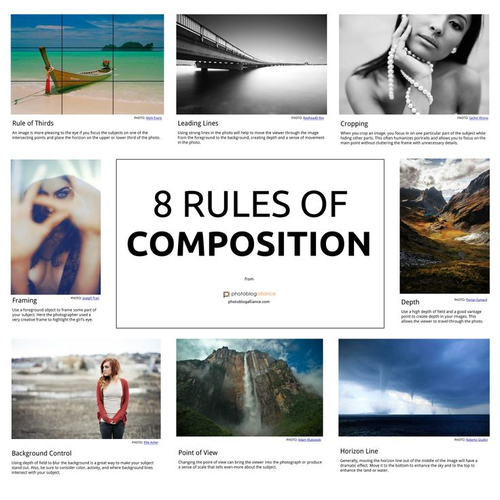
Image source: https://d1uvxqwmcz8fl1.cloudfront.net/tes/resources/11328890/e6063ec5-ac32-4e82-8a45-15745c6bde8e/image?width=500&height=500&version=1469215927641
Composition is the process in which different elements or parts of an image are brought together to form a significant whole. A good picture cannot just be created with a click of a button, especially, when digital photography has made things easier and there are now a host of photography holidays and photography courses on offer making it even more accessible for everyone! The essence of a picture lies in its perfect composition.
Now, composition is something for which you need to have a different outlook apart from your passion for photography. While the basic rules are taught at the very beginning of a photography course or photography holiday, it is practice that makes a photographer perfect.
However, there are some basic rules of composition following which you can improve your skills as well as your photographs.
1. The Rule of Thirds: If you are on a photography holiday, then keep the Rule of Thirds on the top of the list while taking a photograph. This is the most important rule of composition as far as placing the subject matter of your picture is considered. According to this, a frame is first divided into three horizontal and vertical parts. The subject, when placed at the intersection of these lines, makes the best shot. This rule is also applicable when there is more than one subject. Photographers capturing a landscape can decide how much horizon to focus on with the help of this rule. This makes the picture more focused.
2. Frame: Framing includes the use of natural surroundings to add depth to the subject. This can be anything like a window, doorway, tree, etc. Using this rule can help you to focus on the subject and bring it to light. In certain cases, it is better to use a dark frame so that the subject achieves maximum brightness. For the depth, it is better to use a narrow aperture. Such techniques are frequently used by photographers on nature or wildlife photography holidays.
3. Texture: The texture of the subject photographed generates interest in other's mind. This rule is important while picturing leaves, rocks or walls. To make the texture stand out, focus should be on the angle of the light. If the light comes from the side, then the creation of shadows in perfect places will highlight the texture more.
4. Lead Lines: At times, straight, curved or parallel lines in a photograph are helpful in grabbing the attention towards a subject. Keep this in mind while photographing a road, stream, river, bridge, etc. The diagonal placement of these objects is preferred over a horizontal appearance.
5. Colour: This is an essential element in photography whether it is digital photography or still photography. Vibrant colours make a picture look alive and a good composition of one or more colours can make a picture stand out.
6. Simplicity: Last but not the least, keep the picture simple, especially, when the subject is in close focus. In such cases, it is advisable to keep the background as simple as possible.
These are the fundamental rules of composition that should be considered while taking a picture. Though the rules of composition are an integral part of all photography courses in London and photography holidays, it is better to have hands on experience on it.
